S. -H. Gary Chan
Continuous Semi-Implicit Models
Jun 07, 2025Abstract:Semi-implicit distributions have shown great promise in variational inference and generative modeling. Hierarchical semi-implicit models, which stack multiple semi-implicit layers, enhance the expressiveness of semi-implicit distributions and can be used to accelerate diffusion models given pretrained score networks. However, their sequential training often suffers from slow convergence. In this paper, we introduce CoSIM, a continuous semi-implicit model that extends hierarchical semi-implicit models into a continuous framework. By incorporating a continuous transition kernel, CoSIM enables efficient, simulation-free training. Furthermore, we show that CoSIM achieves consistency with a carefully designed transition kernel, offering a novel approach for multistep distillation of generative models at the distributional level. Extensive experiments on image generation demonstrate that CoSIM performs on par or better than existing diffusion model acceleration methods, achieving superior performance on FD-DINOv2.
SnapGen: Taming High-Resolution Text-to-Image Models for Mobile Devices with Efficient Architectures and Training
Dec 12, 2024Abstract:Existing text-to-image (T2I) diffusion models face several limitations, including large model sizes, slow runtime, and low-quality generation on mobile devices. This paper aims to address all of these challenges by developing an extremely small and fast T2I model that generates high-resolution and high-quality images on mobile platforms. We propose several techniques to achieve this goal. First, we systematically examine the design choices of the network architecture to reduce model parameters and latency, while ensuring high-quality generation. Second, to further improve generation quality, we employ cross-architecture knowledge distillation from a much larger model, using a multi-level approach to guide the training of our model from scratch. Third, we enable a few-step generation by integrating adversarial guidance with knowledge distillation. For the first time, our model SnapGen, demonstrates the generation of 1024x1024 px images on a mobile device around 1.4 seconds. On ImageNet-1K, our model, with only 372M parameters, achieves an FID of 2.06 for 256x256 px generation. On T2I benchmarks (i.e., GenEval and DPG-Bench), our model with merely 379M parameters, surpasses large-scale models with billions of parameters at a significantly smaller size (e.g., 7x smaller than SDXL, 14x smaller than IF-XL).
M$^3$-Impute: Mask-guided Representation Learning for Missing Value Imputation
Oct 11, 2024



Abstract:Missing values are a common problem that poses significant challenges to data analysis and machine learning. This problem necessitates the development of an effective imputation method to fill in the missing values accurately, thereby enhancing the overall quality and utility of the datasets. Existing imputation methods, however, fall short of explicitly considering the `missingness' information in the data during the embedding initialization stage and modeling the entangled feature and sample correlations during the learning process, thus leading to inferior performance. We propose M$^3$-Impute, which aims to explicitly leverage the missingness information and such correlations with novel masking schemes. M$^3$-Impute first models the data as a bipartite graph and uses a graph neural network to learn node embeddings, where the refined embedding initialization process directly incorporates the missingness information. They are then optimized through M$^3$-Impute's novel feature correlation unit (FRU) and sample correlation unit (SRU) that effectively captures feature and sample correlations for imputation. Experiment results on 25 benchmark datasets under three different missingness settings show the effectiveness of M$^3$-Impute by achieving 20 best and 4 second-best MAE scores on average.
Revisiting Referring Expression Comprehension Evaluation in the Era of Large Multimodal Models
Jun 24, 2024
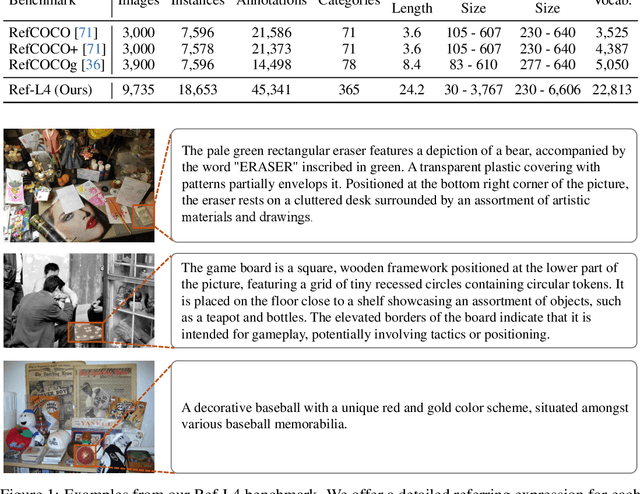

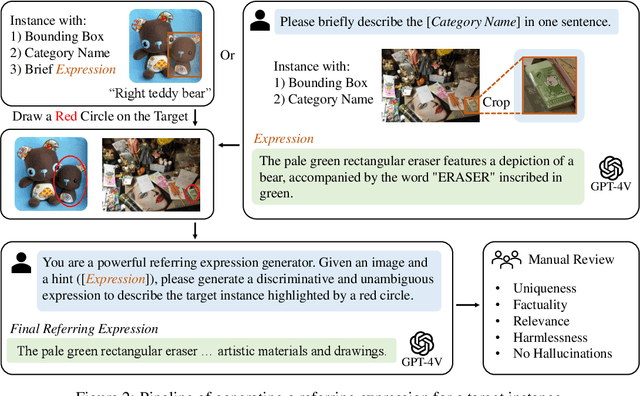
Abstract:Referring expression comprehension (REC) involves localizing a target instance based on a textual description. Recent advancements in REC have been driven by large multimodal models (LMMs) like CogVLM, which achieved 92.44% accuracy on RefCOCO. However, this study questions whether existing benchmarks such as RefCOCO, RefCOCO+, and RefCOCOg, capture LMMs' comprehensive capabilities. We begin with a manual examination of these benchmarks, revealing high labeling error rates: 14% in RefCOCO, 24% in RefCOCO+, and 5% in RefCOCOg, which undermines the authenticity of evaluations. We address this by excluding problematic instances and reevaluating several LMMs capable of handling the REC task, showing significant accuracy improvements, thus highlighting the impact of benchmark noise. In response, we introduce Ref-L4, a comprehensive REC benchmark, specifically designed to evaluate modern REC models. Ref-L4 is distinguished by four key features: 1) a substantial sample size with 45,341 annotations; 2) a diverse range of object categories with 365 distinct types and varying instance scales from 30 to 3,767; 3) lengthy referring expressions averaging 24.2 words; and 4) an extensive vocabulary comprising 22,813 unique words. We evaluate a total of 24 large models on Ref-L4 and provide valuable insights. The cleaned versions of RefCOCO, RefCOCO+, and RefCOCOg, as well as our Ref-L4 benchmark and evaluation code, are available at https://github.com/JierunChen/Ref-L4.
Elevator, Escalator or Neither? Classifying Pedestrian Conveyor State Using Inertial Navigation System
May 06, 2024



Abstract:Classifying a pedestrian in one of the three conveyor states of "elevator," "escalator" and "neither" is fundamental to many applications such as indoor localization and people flow analysis. We estimate, for the first time, the pedestrian conveyor state given the inertial navigation system (INS) readings of accelerometer, gyroscope and magnetometer sampled from the phone. Our problem is challenging because the INS signals of the conveyor state are coupled and perturbed by unpredictable arbitrary human actions, confusing the decision process. We propose ELESON, a novel, effective and lightweight INS-based deep learning approach to classify whether a pedestrian is in an elevator, escalator or neither. ELESON utilizes a motion feature extractor to decouple the conveyor state from human action in the feature space, and a magnetic feature extractor to account for the speed difference between elevator and escalator. Given the results of the extractors, it employs an evidential state classifier to estimate the confidence of the pedestrian states. Based on extensive experiments conducted on twenty hours of real pedestrian data, we demonstrate that ELESON outperforms significantly the state-of-the-art approaches (where combined INS signals of both the conveyor state and human actions are processed together), with 15% classification improvement in F1 score, stronger confidence discriminability with 10% increase in AUROC (Area Under the Receiver Operating Characteristics), and low computational and memory requirements on smartphones.
Single Domain Generalization for Crowd Counting
Mar 14, 2024Abstract:Current image-based crowd counting widely employs density map regression due to its promising results. However, the method often suffers from severe performance degradation when tested on data from unseen scenarios. To address this so-called "domain shift" problem, we investigate single domain generalization (SDG) for crowd counting. The existing SDG approaches are mainly for classification and segmentation, and can hardly be extended to our case due to its regression nature and label ambiguity (i.e., ambiguous pixel-level ground truths). We propose MPCount, a novel SDG approach effective even for narrow source distribution. Reconstructing diverse features for density map regression with a single memory bank, MPCount retains only domain-invariant representations using a content error mask and attention consistency loss. It further introduces patch-wise classification as an auxiliary task to boost the robustness of density prediction to achieve highly accurate labels. Through extensive experiments on different datasets, MPCount is shown to significantly improve counting accuracy compared to the state of the art under diverse scenarios unobserved in the training data of narrow source distribution. Code is available at https://github.com/Shimmer93/MPCount.
Target-agnostic Source-free Domain Adaptation for Regression Tasks
Dec 01, 2023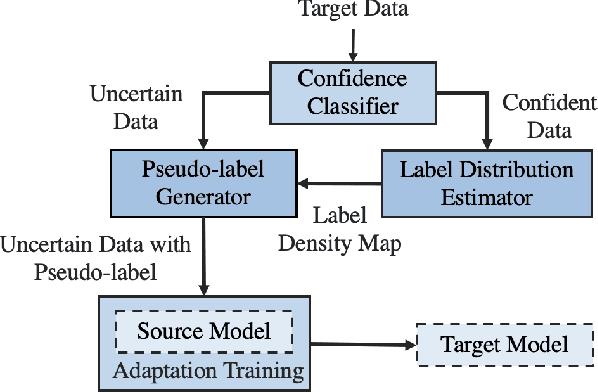
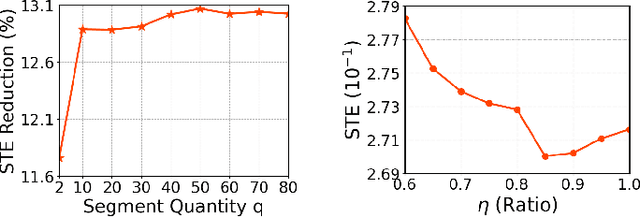
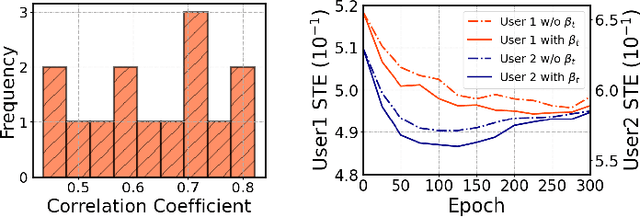

Abstract:Unsupervised domain adaptation (UDA) seeks to bridge the domain gap between the target and source using unlabeled target data. Source-free UDA removes the requirement for labeled source data at the target to preserve data privacy and storage. However, work on source-free UDA assumes knowledge of domain gap distribution, and hence is limited to either target-aware or classification task. To overcome it, we propose TASFAR, a novel target-agnostic source-free domain adaptation approach for regression tasks. Using prediction confidence, TASFAR estimates a label density map as the target label distribution, which is then used to calibrate the source model on the target domain. We have conducted extensive experiments on four regression tasks with various domain gaps, namely, pedestrian dead reckoning for different users, image-based people counting in different scenes, housing-price prediction at different districts, and taxi-trip duration prediction from different departure points. TASFAR is shown to substantially outperform the state-of-the-art source-free UDA approaches by averagely reducing 22% errors for the four tasks and achieve notably comparable accuracy as source-based UDA without using source data.
A Multi-Scale Decomposition MLP-Mixer for Time Series Analysis
Oct 18, 2023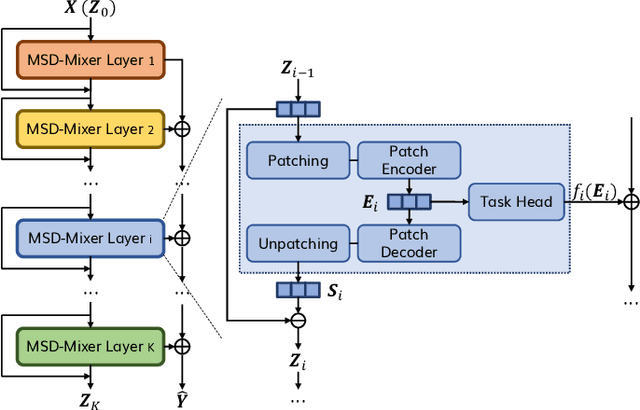
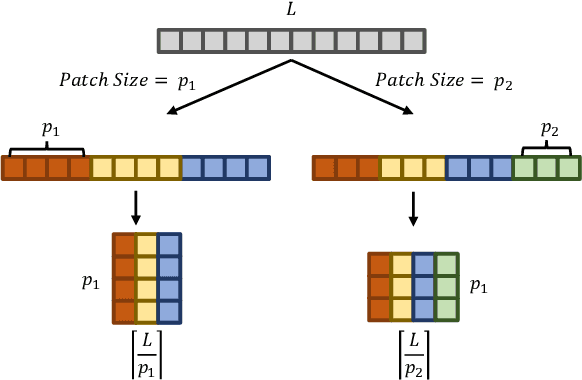
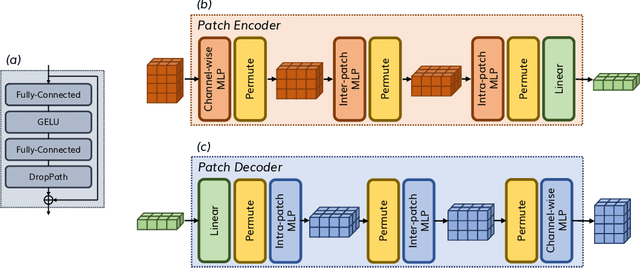
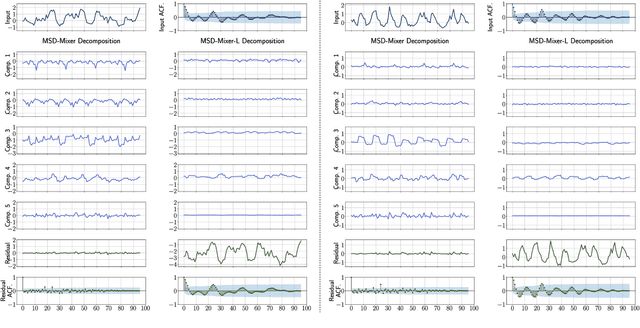
Abstract:Time series data, often characterized by unique composition and complex multi-scale temporal variations, requires special consideration of decomposition and multi-scale modeling in its analysis. Existing deep learning methods on this best fit to only univariate time series, and have not sufficiently accounted for sub-series level modeling and decomposition completeness. To address this, we propose MSD-Mixer, a Multi-Scale Decomposition MLP-Mixer which learns to explicitly decompose the input time series into different components, and represents the components in different layers. To handle multi-scale temporal patterns and inter-channel dependencies, we propose a novel temporal patching approach to model the time series as multi-scale sub-series, i.e., patches, and employ MLPs to mix intra- and inter-patch variations and channel-wise correlations. In addition, we propose a loss function to constrain both the magnitude and autocorrelation of the decomposition residual for decomposition completeness. Through extensive experiments on various real-world datasets for five common time series analysis tasks (long- and short-term forecasting, imputation, anomaly detection, and classification), we demonstrate that MSD-Mixer consistently achieves significantly better performance in comparison with other state-of-the-art task-general and task-specific approaches.
Improving Out-of-Distribution Robustness of Classifiers via Generative Interpolation
Jul 23, 2023Abstract:Deep neural networks achieve superior performance for learning from independent and identically distributed (i.i.d.) data. However, their performance deteriorates significantly when handling out-of-distribution (OoD) data, where the training and test are drawn from different distributions. In this paper, we explore utilizing the generative models as a data augmentation source for improving out-of-distribution robustness of neural classifiers. Specifically, we develop a simple yet effective method called Generative Interpolation to fuse generative models trained from multiple domains for synthesizing diverse OoD samples. Training a generative model directly on the source domains tends to suffer from mode collapse and sometimes amplifies the data bias. Instead, we first train a StyleGAN model on one source domain and then fine-tune it on the other domains, resulting in many correlated generators where their model parameters have the same initialization thus are aligned. We then linearly interpolate the model parameters of the generators to spawn new sets of generators. Such interpolated generators are used as an extra data augmentation source to train the classifiers. The interpolation coefficients can flexibly control the augmentation direction and strength. In addition, a style-mixing mechanism is applied to further improve the diversity of the generated OoD samples. Our experiments show that the proposed method explicitly increases the diversity of training domains and achieves consistent improvements over baselines across datasets and multiple different distribution shifts.
FIS-ONE: Floor Identification System with One Label for Crowdsourced RF Signals
Jul 12, 2023Abstract:Floor labels of crowdsourced RF signals are crucial for many smart-city applications, such as multi-floor indoor localization, geofencing, and robot surveillance. To build a prediction model to identify the floor number of a new RF signal upon its measurement, conventional approaches using the crowdsourced RF signals assume that at least few labeled signal samples are available on each floor. In this work, we push the envelope further and demonstrate that it is technically feasible to enable such floor identification with only one floor-labeled signal sample on the bottom floor while having the rest of signal samples unlabeled. We propose FIS-ONE, a novel floor identification system with only one labeled sample. FIS-ONE consists of two steps, namely signal clustering and cluster indexing. We first build a bipartite graph to model the RF signal samples and obtain a latent representation of each node (each signal sample) using our attention-based graph neural network model so that the RF signal samples can be clustered more accurately. Then, we tackle the problem of indexing the clusters with proper floor labels, by leveraging the observation that signals from an access point can be detected on different floors, i.e., signal spillover. Specifically, we formulate a cluster indexing problem as a combinatorial optimization problem and show that it is equivalent to solving a traveling salesman problem, whose (near-)optimal solution can be found efficiently. We have implemented FIS-ONE and validated its effectiveness on the Microsoft dataset and in three large shopping malls. Our results show that FIS-ONE outperforms other baseline algorithms significantly, with up to 23% improvement in adjusted rand index and 25% improvement in normalized mutual information using only one floor-labeled signal sample.
 Add to Chrome
Add to Chrome Add to Firefox
Add to Firefox Add to Edge
Add to Edge